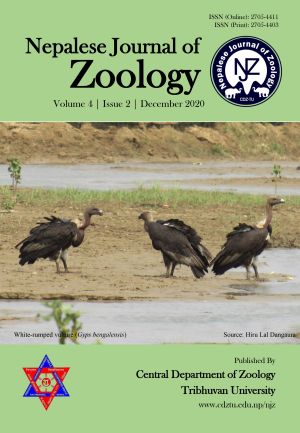Diversity of snake in Kaski district of Gandaki Province, Nepal
DOI:
https://doi.org/10.3126/njz.v4i2.33892Keywords:
Hemotoxic, Kaski district, Neurotoxic, Weakly venomousAbstract
Snakes are one of the most diverse vertebrates on the globe, mostly prefer arid zones. Nepal harbors a high unrecognized reptilian diversity. Information on the diversity and distribution of snakes in the western Nepal are derived from relatively from old literatures. This study updated the diversity and distribution of snakes from the Kaski district based on rescuing activities, field survey and literature review. Altogether 40 species of snake from five families were recorded in the Kaski district. The family Colubridae (70%) had the highest species diversity followed by Elapidae (12.5%), Viperidae (12.5%), Pythonidae (2.5 %), and Typhlopidae (2.5 %) respectively. Based on the IUCN global status of snake, 5 % are vulnerable, 5 % data deficient, 27.5 % are Least Concern and 62.5 % are Not Evaluated. Six species were found new distribution records in Kaski. Four species were the species listed on CITES II. Out of 40 species, 27.5% venomous (2.5 % were venomous but not fatal to human, 12.5% were neurotoxic, 12.5% were hemotoxic which are deadly venomous), 20% were weakly venomous and not fatal to human and 50 % were non-venomous. Habitat loss, nest destroyed, road-killed and meaningless killing by the negative perception of people was the most threat to snake in Kaski district.
Downloads
Downloads
Published
How to Cite
Issue
Section
License
This license enables reusers to distribute, remix, adapt, and build upon the material in any medium or format for noncommercial purposes only, and only so long as attribution is given to the creator.

